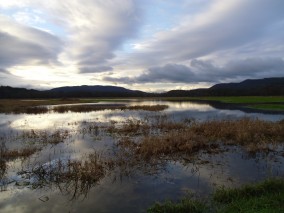Water plays key role in weather and our lives
- Article Published At:
- Rutland Herald & Barre-Montpelier Times-Argus
- Date of Publication:
- November 25th, 2012
Early in the morning, I love to watch the clouds and the rising sun reflected in the still waters of the flood plain below our house. (See Figure .) Water is at the heart of our lives and the climate of Earth. In the sky, water vapor, a crucial greenhouse gas, slows the cooling of the Earth to space. Too much can give us muggy summer nights, while too little gives us the bitter cold of clear nights in deep winter. Without the greenhouse gases, water vapor and carbon dioxide, the Earth would not be habitable. Over hundreds of millions of years, plant life on Earth through photosynthesis has been drawing on the CO2 in the atmosphere, storing some of it in the Earth as fossil carbon. Now we are burning these stored fossil fuels in a century or so, pushing the earth towards the much warmer climate of a hundred million years ago.
The balance between plants, water, CO2 and sky is a fascinating one. Using a few percent of sunlight, plants convert CO2 and water into their tissues and energy stores - like the carbohydrates which provide food for humanity. But at the same time, they also lose water when their stomata, the tiny pores in leaves, open to take in CO2. The evaporation of this precious water absorbs much of the sun’s energy, and this keeps the leaf and the surface of the Earth cool.
What is left of the sun’s energy heats the surface — enough to drive thermals that lift the water vapor, cooling as it rises, until it condenses in the updrafts of clouds. This condensation releases the energy coming from the sun that evaporated the water, providing the driving force for thunderstorms, which transport water high in the atmosphere. Most falls out as rain, sometimes hail, while some flows out in cirrus clouds, evaporating again to give the Earth that precious greenhouse blanket of water vapor high in the atmosphere.
Plants take water from the soil, use some to grow and evaporate some into the air. Clouds lift the vapor and recycle most of it as rain in summer to moisten the soil downwind. On average, garden vegetables, field crops and forests need at least a tenth of an inch of water every day. Our summer rainfall averages about 3 to 4 inches a month, so it is just enough. The soil serves as a buffer; each foot of soil can store about two inches of water and supply roots with water for a couple of weeks if there is no rain. Trees that have deeper roots can withstand droughts for much longer periods.
In early spring the ground is saturated with water after snowmelt. This provides extra water for the flush of spring growth into the early summer. But last winter was warm, with much less snow that melted quickly. We began spring with less water in the ground, and we also had a drier summer in Vermont. This was the first summer in years that I needed to water my vegetables once or twice.
Much of the plains and mountain states had even less summer rain than Vermont, after a winter with below average snowfall. Because the spring soils were dryer, less water could evaporate — giving less rainfall as a result. When a high pressure settled in over the central part of the country, severe to exceptional drought conditions developed across 40 percent of the U.S. mainland. Without water the humidity fell, forest fires blazed, and record temperatures baked the land and shriveled crops.
Water plays a central role in most weather extremes and disasters. Wet soils and warm oceans increase evaporation and amplify storms and floods. Dry soils reduce evaporation and transpiration from plants, which can lock in drought over the continent.
Most of the time we take water for granted. But these extreme weather events remind us that water deserves our gratitude as a sustainer of life, and our humble respect as a major force in our climate.
Related Topics
Figures and Images
 Figure 1: Reflected Sky at Dawn (2 Nov 2012)Reflected Sky at Dawn - Pittsford, November 2, 2012
Figure 1: Reflected Sky at Dawn (2 Nov 2012)Reflected Sky at Dawn - Pittsford, November 2, 2012